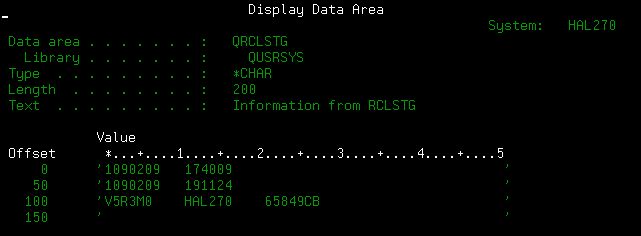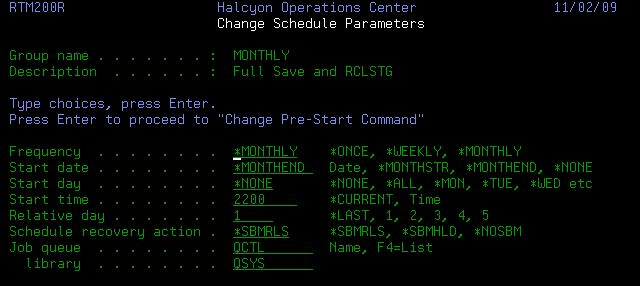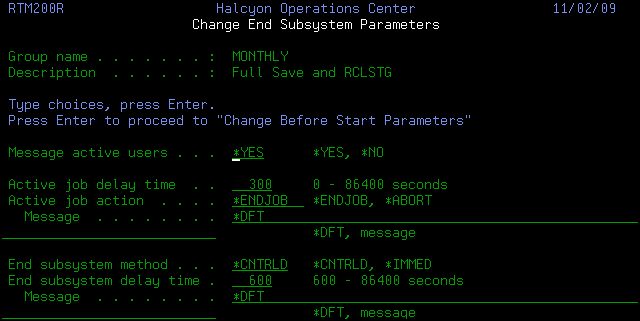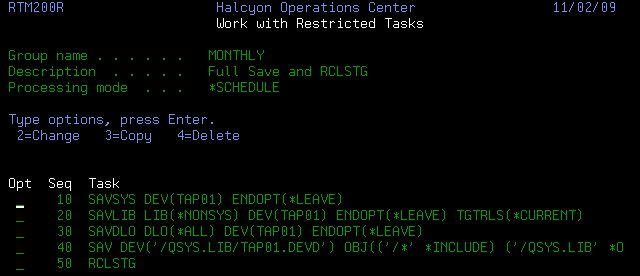Manually reclaiming storage is a hassle. Wouldn't you rather automate that process?
Every now and again, a System i administrator should run the Reclaim Storage (RCLSTG) command on the system. If you've got limited experience with the platform, the system, or even the command itself, then you may not be aware of what it does and how best to schedule it.
Why Should I Run a RCLSTG?
Look at the RCLSTG as a "spring cleaning" for your system. The process checks the headers and pointers on all objects in the Auxiliary Storage Pool (ASP) and attempts to validate and reclaim orphaned, damaged, and incorrectly updated objects.
As the RCLSTG command also deletes unusable objects or fragments, it's especially relevant after a sudden power failure or system crash.
How Long Will It Take to Run?
This is very difficult to estimate, but probably the best way is to check how long it ran the last time. Display the data area QUSRSYS/QRCLSTG using this command:
DSPDTAARA DTAARA(QUSRSYS/QRCLSTG)
Figure 1: Determine how long RCLSTG ran.
Our example shows that the last RCLSTG ran from 1740 to 1911 (5:40 p.m. to 7:11 p.m.) on February 9, 2009.
What Preparation Should I Undertake?
As the RCLSTG could (albeit unlikely) impact the day-to-day running of the system, it's advisable to perform a full system backup and if possible an IPL prior to running the command.
How Do I Run a RCLSTG?
You'll need to sign on using a QSECOFR profile or an equivalent profile before bringing the system to a restricted state (all jobs need to be ended apart from the system console). After ensuring that all users have signed off and that all batch processes are complete, a restricted state can be achieved by using this command:
ENDSBS SBS(*ALL) OPTION(*IMMED)
The system is in a restricted state when you see the CPF0968 message on the QSYSOPR message queue.
Figure 2: CPF0968 indicates that the system is in a restricted state.
Once the system is ready, issue this command:
RCLSTG
Of course, the process described is very manual and somewhat dated, so why not schedule the whole process using Halcyon's Restricted Task Manager? It's so simple!
Decide when you want to run it.
Figure 3: Choose when to run RCLSTG.
Then decide how you'd like to achieve a restricted state--by automatically notifying the online users or not.
Figure 4: Choose how to achieve a restricted state.
Next, decide what you want to run--in our example, a SAVSYS, *NONSYS, SAVDLO, and a SAV followed by RCLSTG, all with built-in error recovery and Short Message Service (SMS) task-completion capabilities.
Figure 5: Choose what you want to run.
Post-RCLSTG Checks
1. Informational status messages will be sent to the session running the RCLSTG, but it's good practice to check the QSYSOPR message queue for any anomalies when RCLSTG completes.
2. Any objects found to be secured by damaged or missing authorization lists are assigned to the QRCLAUTL authorization and should be reviewed by using the command DSPAUTLOBJ AUTL(QRCLAUTL).
3. Check for any objects discovered that are owned by a damaged or deleted user profile or any objects that have no owners as assigned to QDFTOWN. These objects can be reviewed by using the command WRKOBJOWN USRPRF(QDFTOWN).
4. Any objects that are lost from their original specified location are placed in QRCL for qsys.lib objects and /QReclaim or /QOpenSys/QReclaim for IFS objects. Review these by using the commands below:
DSPLIB LIB(QRCL)
WRKLNK OBJ('/QOpenSys/QReclaim')
WRKLNK OBJ('/QReclaim')
Automatically reclaiming storage is easy and painless with Halcyon's Restricted Task Manager. Eliminate the hassles of manual storage reclamation!


























 More than ever, there is a demand for IT to deliver innovation. Your IBM i has been an essential part of your business operations for years. However, your organization may struggle to maintain the current system and implement new projects. The thousands of customers we've worked with and surveyed state that expectations regarding the digital footprint and vision of the company are not aligned with the current IT environment.
More than ever, there is a demand for IT to deliver innovation. Your IBM i has been an essential part of your business operations for years. However, your organization may struggle to maintain the current system and implement new projects. The thousands of customers we've worked with and surveyed state that expectations regarding the digital footprint and vision of the company are not aligned with the current IT environment. TRY the one package that solves all your document design and printing challenges on all your platforms. Produce bar code labels, electronic forms, ad hoc reports, and RFID tags – without programming! MarkMagic is the only document design and print solution that combines report writing, WYSIWYG label and forms design, and conditional printing in one integrated product. Make sure your data survives when catastrophe hits. Request your trial now! Request Now.
TRY the one package that solves all your document design and printing challenges on all your platforms. Produce bar code labels, electronic forms, ad hoc reports, and RFID tags – without programming! MarkMagic is the only document design and print solution that combines report writing, WYSIWYG label and forms design, and conditional printing in one integrated product. Make sure your data survives when catastrophe hits. Request your trial now! Request Now. Forms of ransomware has been around for over 30 years, and with more and more organizations suffering attacks each year, it continues to endure. What has made ransomware such a durable threat and what is the best way to combat it? In order to prevent ransomware, organizations must first understand how it works.
Forms of ransomware has been around for over 30 years, and with more and more organizations suffering attacks each year, it continues to endure. What has made ransomware such a durable threat and what is the best way to combat it? In order to prevent ransomware, organizations must first understand how it works. Disaster protection is vital to every business. Yet, it often consists of patched together procedures that are prone to error. From automatic backups to data encryption to media management, Robot automates the routine (yet often complex) tasks of iSeries backup and recovery, saving you time and money and making the process safer and more reliable. Automate your backups with the Robot Backup and Recovery Solution. Key features include:
Disaster protection is vital to every business. Yet, it often consists of patched together procedures that are prone to error. From automatic backups to data encryption to media management, Robot automates the routine (yet often complex) tasks of iSeries backup and recovery, saving you time and money and making the process safer and more reliable. Automate your backups with the Robot Backup and Recovery Solution. Key features include: Business users want new applications now. Market and regulatory pressures require faster application updates and delivery into production. Your IBM i developers may be approaching retirement, and you see no sure way to fill their positions with experienced developers. In addition, you may be caught between maintaining your existing applications and the uncertainty of moving to something new.
Business users want new applications now. Market and regulatory pressures require faster application updates and delivery into production. Your IBM i developers may be approaching retirement, and you see no sure way to fill their positions with experienced developers. In addition, you may be caught between maintaining your existing applications and the uncertainty of moving to something new. IT managers hoping to find new IBM i talent are discovering that the pool of experienced RPG programmers and operators or administrators with intimate knowledge of the operating system and the applications that run on it is small. This begs the question: How will you manage the platform that supports such a big part of your business? This guide offers strategies and software suggestions to help you plan IT staffing and resources and smooth the transition after your AS/400 talent retires. Read on to learn:
IT managers hoping to find new IBM i talent are discovering that the pool of experienced RPG programmers and operators or administrators with intimate knowledge of the operating system and the applications that run on it is small. This begs the question: How will you manage the platform that supports such a big part of your business? This guide offers strategies and software suggestions to help you plan IT staffing and resources and smooth the transition after your AS/400 talent retires. Read on to learn:
LATEST COMMENTS
MC Press Online